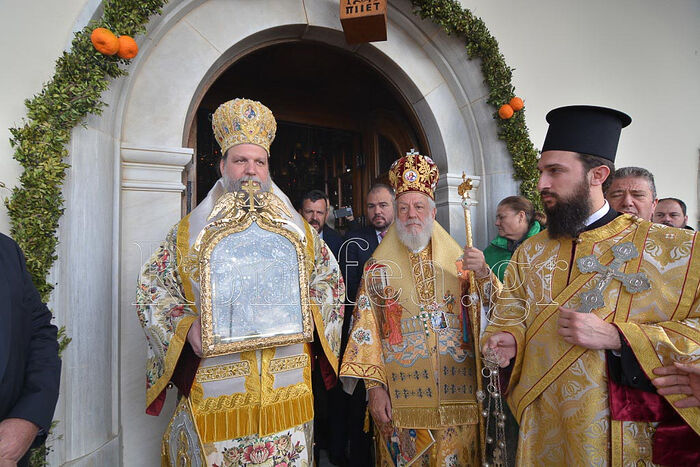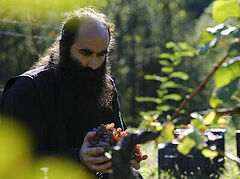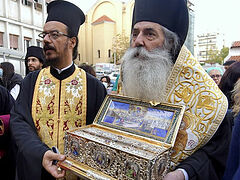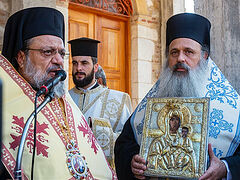Tinos, Cyclades, Greece, January 30, 2023
Thousands of Greek Orthodox faithful came out to the Holy Church of the Evangelistria in Tinos last night and this morning to celebrate the 200th anniversary of the discovery of the wonderworking Panagia of Tinos Icon.
Metropolitan Dorotheos of Syros and Tinos began the feast with the celebration of Great Vespers yesterday, after which the icon was carried in procession. The All-Night Vigil was celebrated later in the evening, reports Ekklisia Online.
This morning, the Divine Liturgy was celebrated by Met. Dorotheos and Metropolitan Gabriel of Nea Ionia and Philadelphia, followed by another procession with the wonderworking icon, reports Romfea.
Today is a double feast for the island of Tinos, which also celebrated the new calendar feast of the Three Holy Hierarchs—Sts. Basil the Great, Gregory the Theologian, and John Chrysostom.
This evening, the faithful will again gather at the Church of the Evangelistria for the unique Tinian tradition of a torchlight procession. Every local has their own lantern, often made by children, which they hang from high wooden poles during the procession.
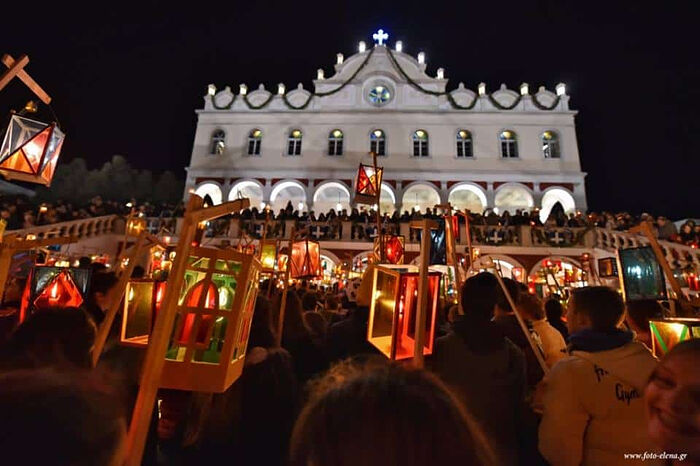 From the torchlight procession in 2017. Photo: mygreekheart.com
From the torchlight procession in 2017. Photo: mygreekheart.com
***
The story of the discovery of the Tinos Icon from the site of the Orthodox Church in America:
 This highly-venerated icon of the Annunciation was discovered in the ruins of the ancient church of Saint John the Baptist on January 30, 1823.
This highly-venerated icon of the Annunciation was discovered in the ruins of the ancient church of Saint John the Baptist on January 30, 1823.
An elderly man, Michael Polyzoes, had a dream shortly before the Feast of the Annunciation in 1821, in which the Mother of God appeared to him in shining white garments. She instructed him to dig in the field of Anthony Doxaras outside the city, where he would find her icon. She also told him to build a church on the site, since there had once been one there. The Queen of Heaven also promised to help him accomplish these tasks.
Upon awakening, he crossed himself and tried to go back to sleep, believing that his dream had been a temptation from the devil. Before falling asleep, Michael saw the Theotokos once again, and noticed that the room was flooded by a gentle white light. Her head was surrounded by divine light, and her face displayed ineffable grace and sweetness. Speaking to the old man she said, “Why are you afraid? Your fear comes from unbelief. Listen! I am Panagia (the all-holy one). I want you to dig in the field of Anthony Doxaras where my icon is buried. I ask you to do this as a favor, old man. You will build a church there and I will help you.” Then she disappeared.
The next morning, Michael went into the village and told the priest what had happened to him during the night. The priest also thought the dream was a temptation, so he urged Michael to come for Confession and Communion. The old man, however, was not convinced that his visions were mere dreams or demonic temptations. He told the inhabitants of the village of his experience. Some laughed at him, but only two believed his words.
The two men went with him to the field one night and dug in many places, but they found nothing. Then they dug in another place and found the remains of an old wall. Finding nothing but bricks, they had to give up their search in the morning so the Turks would not find out what they were doing.
Anthony Doxaras, the owner of the field, found the bricks and tried to use them to build an oven. The mortar would not adhere to the bricks, so whenever they tried to build one section of the oven, it collapsed. The workers were convinced that God was showing them that the bricks from the ancient church were not to be used for an oven.
Saint Pelagia (July 23), an eighty-year-old nun, had several dreams in June of 1822 in which the Most Holy Theotokos appeared to her. Saint Pelagia was living in the women’s monastery of the Dormition on Mt. Kechrovounios, about an hour’s journey from the village. She had lived in the monastery from a young age, and was known for her great virtue and piety.
The Theotokos appeared to her in a dream and ordered her to go to Stamatelos Kangades (a prominent man of the village), and tell him to uncover the church of Saint John the Baptist in the field of Anthony Doxaras.
Terrified by the vision, Pelagia attributed the dream to her imagination, and she began to pray. She was afraid to tell anyone about her dream, but the following week, the Theotokos appeared to her again, reminding her of her instructions. Still, the nun remained silent and told no one of her vision. The Theotokos appeared a third time, this time with a severe manner. She chastised the nun for her unbelief, saying, “Go and do as I told you. Be obedient.”
Saint Pelagia woke up in fear and trembling. As she opened her eyes, she saw the same mysterious Woman she had seen while asleep. With a great effort she asked, “Who are you, Lady? Why are you angry with me, and why do you order me to do these things?”
The Woman raised her hand and said, “Proclaim, O earth, glad tidings of great joy” (Megalynarion of the Ninth Ode of the Canon for Matins of the Annunciation).
Understanding at last, the aged nun joyfully exclaimed, “Praise, O heavens, the glory of God” (The next line of the Megalynarion).
At once, she informed the Abbess of her visions, and she also told Stamatelos Kangades. Mr. Kangades, who had been designated by the Theotokos to carry out the excavation of the church, informed Bishop Gabriel of these events. The bishop had already heard of the dream of Michael Polyzoes, and realized that the account of the nun Pelagia agreed with his vision. Bishop Gabriel wrote to all the churches on the island of Tinos, urging them to cooperate in finding the church and the icon.
Excavations began in September of 1822 under the supervision of Mr. Kangades. The foundations of the church of Saint John, destroyed by Arabs in 1200, were uncovered. An old well was found near the church, but not the holy icon. The money ran out, and so the effort was abandoned.
Once again the Mother of God appeared to Saint Pelagia, urging that the excavations continue. Bishop Gabriel sent out an appeal for donations to build a new church on the foundations of the old church of Saint John the Baptist. The new church was built, and was dedicated to Saint John and to the Life-Giving Fountain.
On January 30, 1823 workers were leveling the ground inside the church in preparation for laying a new stone floor. About noon one of the workers, Emmanuel Matsos, struck a piece of wood with his pickaxe, splitting it down the middle. He looked at one piece of the board and saw that it was burned on one side, while the other side showed traces of paint. As he brushed off the dirt with his hand, he saw that it was an icon. Joining the two pieces of wood together, he crossed himself and venerated the icon.
He called the other workers, who also came and venerated the icon. When the icon was cleaned, it was shown to be an icon of the Annunciation. The split was in the middle of the icon, between the Theotokos and the Archangel Gabriel. Neither figure was damaged, and this was regarded as a miracle.
That same day, the icon was given to Bishop Gabriel, who kissed it and cried out, “Great art Thou, O Lord, and wondrous are Thy works.”
After the finding of the icon, the inabitants of Tinos were filled with zeal to build a magnificent church in honor of the Theotokos. People offered their money and their own labor to help build the church of the Evangelistria (She who received the Good News).
The new church was completed in 1823, and was consecrated by Bishop Gabriel. Saint Pelagia of Tinos fell asleep in the Lord on April 28, 1834. Her Feast Day, however, is on July 23.
The Tinos Icon of the Most Holy Theotokos continues to be venerated as one of Greece’s holiest treasures. Innumerable miracles of healing and deliverance from danger have not ceased since the time the icon was found.
Follow OrthoChristian on Twitter, Vkontakte, Telegram, WhatsApp, MeWe, and Gab!

